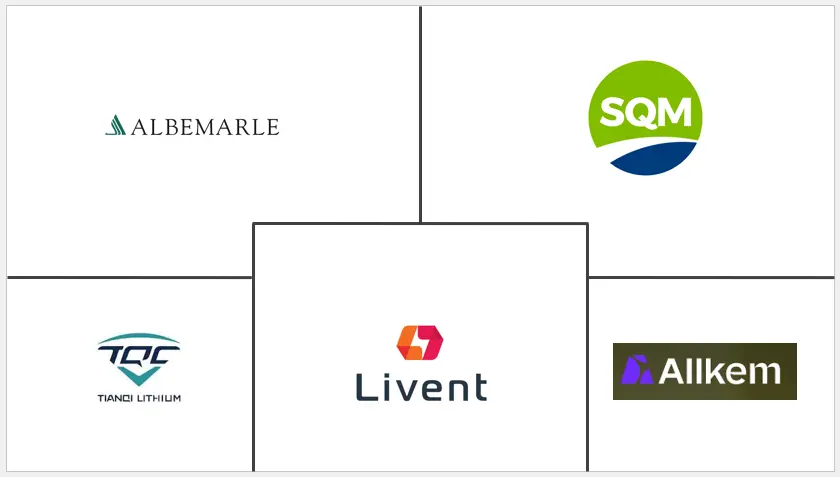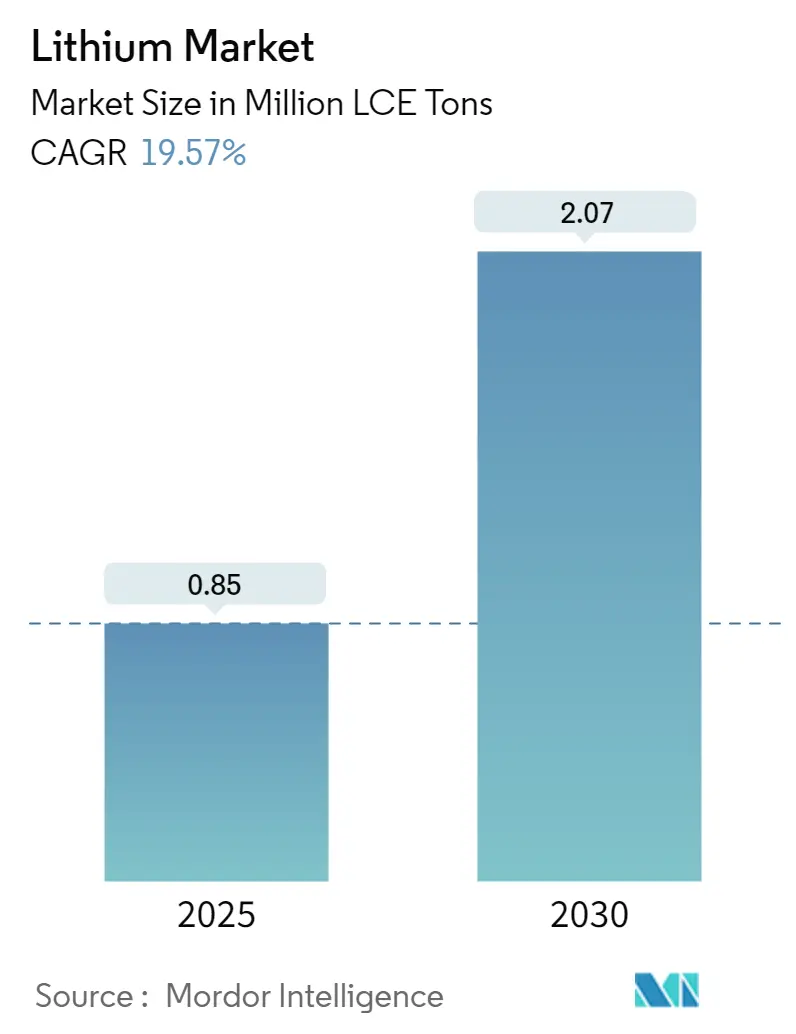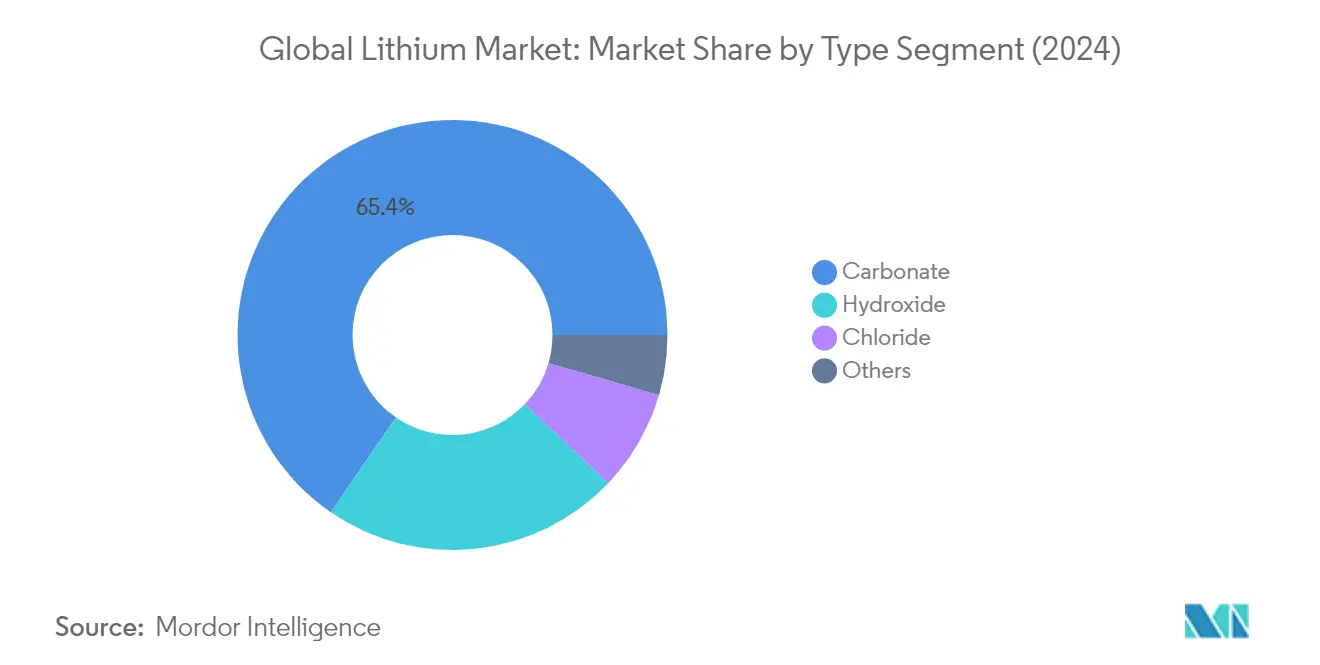Lithium Market Analysis
The Lithium Market size is estimated at 0.85 million lce tons in 2025, and is expected to reach 2.07 million lce tons by 2030, at a CAGR of 19.57% during the forecast period (2025-2030).
The global lithium industry is experiencing significant transformation driven by supply chain reorganization and geographical concentration of production. According to CNBC, lithium production remains highly concentrated, with Chile, Argentina, Australia, and China accounting for over 82% of global production in 2022. This concentration has led to an increased focus on supply chain resilience, with many countries developing strategies to secure stable lithium supplies. Major mining companies are expanding their operational footprint through strategic acquisitions and joint ventures, while new players are entering the lithium market to capitalize on growing demand.
The lithium market is witnessing substantial investments in processing infrastructure and technology development. Global investment in battery energy storage exceeded USD 20 billion in 2022, predominantly in grid-scale deployment, which represented more than 65% of total spending. Companies are increasingly focusing on developing more efficient extraction and lithium processing technologies, including direct lithium extraction (DLE) methods and improved brine processing techniques. These technological advancements are aimed at reducing production costs and environmental impact while improving recovery rates.
The market is characterized by rapid capacity expansion and production scale-up efforts to address anticipated supply shortages. Global lithium production reached 170.8 kilotons in 2023, marking a significant 31.3% increase from 2022 levels. Industry stakeholders are actively working to bridge the growing supply-demand gap through greenfield projects and brownfield expansions. This includes the development of new mining operations, processing facilities, and recycling infrastructure to ensure sustainable supply chains.
The industry landscape is being reshaped by strategic partnerships and vertical integration initiatives across the value chain. Major automotive manufacturers are increasingly entering into direct sourcing agreements with lithium producers, while battery manufacturers are backward integrating into raw material production. These strategic moves are accompanied by significant investments in research and development, particularly in areas such as solid-state batteries and advanced recycling technologies. The lithium industry must quadruple production between 2020 and 2030, reaching 2 million tons to meet projected demand, driving unprecedented levels of investment and technological innovation. The lithium market outlook remains robust, with a focus on sustainability and innovation.
Lithium Market Trends
Accelerating Demand for Electric Vehicles
The electric vehicle industry has witnessed unprecedented growth, driven by increasing environmental consciousness and supportive government policies worldwide. According to the International Energy Agency, nearly 14 million electric cars were sold in 2023, building on the more than 2.3 million already sold in the year's first quarter. This represents a 35% increase in electric car sales compared to 2022, bringing the global electric sales share to around 18%. The surge in EV adoption has created massive demand for lithium-ion batteries, as these power sources offer high energy per unit mass, a high power-to-weight ratio, high energy efficiency, superior high-temperature performance, and low self-discharge characteristics.
The automotive industry's commitment to electric mobility is evidenced by significant investments from major manufacturers. For instance, BYD is expected to deliver over three million EVs in 2023, while Tesla remains the most significant battery electric vehicle player globally. Companies like Volkswagen Group are expected to exceed the one million EV mark in 2024, with Hyundai Motor, General Motors, and Stellantis following suit in 2025. The unit volume of global EV sales is projected to triple from 10.5 million in 2022 to over 31 million in 2027, and further double to over 74.5 million units in 2035. This exponential growth in electric vehicle production and sales directly correlates to increased demand for EV battery materials, as lithium is an essential component in EV batteries.
Increasing Usage and Demand by Portable Consumer Electronics
The critical consumption of lithium in consumer electronics is primarily driven by batteries used in various household appliances and electronic devices. The increasing demand for portable devices, such as mobile phones, portable chargers, watch and clock batteries, and cameras, is boosting the demand for lithium battery materials globally. Lithium-ion batteries are widely preferred for mobile phones and other portable electronics owing to their long-lasting charge, lightweight nature, high energy density, and rechargeability characteristics. These batteries demonstrate superior performance with no memory effect, making them the most efficient power sources for smartphones, laptops, and other portable electronic devices.
The electronics industry has witnessed significant technological advancements, with the rollout of 5G technology and standards evolving worldwide. According to the German Electrical and Electronic Manufacturers Association (ZVEI), the global electronics market is expected to grow to EUR 169.50 billion in 2023. The rising disposable income, increasing adoption of smart devices, technology proliferation, development of the semiconductor industry, and increasing penetration of the Internet of Things (IoT) have further fueled the growth of consumer electronics. Additionally, the Japan Electronics and Information Technology Industries Association (JEITA) reported that the production value of consumer electronic equipment reached JPY 23,425 million in January 2023, registering a significant growth rate of 79.8% compared to the same period in the previous year, demonstrating the robust demand for electronic devices and consequently, lithium batteries.
Segment Analysis: Type
Carbonate Segment in Global Lithium Market
The lithium carbonate segment dominates the global lithium market, holding approximately 65% market share in 2024. This significant market position is primarily driven by its extensive use in lithium battery materials, particularly for electric vehicles and energy storage applications. The segment's dominance is further strengthened by its widespread application in ceramics, glass manufacturing, and other industrial processes. Battery-grade lithium carbonate continues to see robust demand from major electric vehicle manufacturers and battery producers worldwide, while technical-grade carbonate maintains steady demand from traditional industries like ceramics and glass manufacturing.
Hydroxide Segment in Global Lithium Market
The lithium hydroxide segment is experiencing the fastest growth in the global lithium market, with an expected growth rate of approximately 24% during 2024-2029. This remarkable growth is primarily attributed to its increasing adoption in high-nickel content cathode materials for electric vehicle batteries, which offer higher energy density and improved performance. The segment's growth is further supported by technological advancements in battery manufacturing processes and the automotive industry's shift towards high-performance electric vehicles. Major battery manufacturers are increasingly preferring lithium hydroxide for next-generation battery technologies, driving substantial investments in hydroxide production capacity worldwide.
Remaining Segments in Type Segmentation
The remaining segments in the lithium market include lithium chloride, lithium metal, alloys, and other lithium compounds. Lithium chloride plays a crucial role in air treatment applications and as a precursor in lithium metal production. The metal and alloy segments serve specialized applications in aerospace, electronics, and specialized battery technologies. These segments, while smaller in market share, are essential for specific industrial applications and continue to maintain steady demand from their respective end-use industries. The diversity of these segments helps maintain market stability and provides opportunities for manufacturers to serve niche applications with specialized lithium chemicals.
Segment Analysis: Application
Battery Segment in Lithium Market
The battery segment dominates the global lithium market, commanding approximately 70% of the total market share in 2024. This substantial market position is primarily driven by the accelerating demand for battery metals in electric vehicles, consumer electronics, and energy storage systems. The segment's dominance is further reinforced by major investments in battery manufacturing facilities worldwide, with significant expansions in Europe, North America, and Asia-Pacific regions. The increasing focus on renewable energy integration and grid storage solutions has also contributed to the segment's growth. Additionally, the battery segment is experiencing the highest growth rate in the lithium market, with an expected growth of approximately 22% from 2024 to 2029, driven by ambitious electric vehicle adoption targets set by various countries and the growing emphasis on sustainable energy storage solutions.
Remaining Segments in Application Market
The lithium market encompasses several other significant application segments beyond batteries. Glass and ceramics represent the second-largest application, where lithium compounds are essential for improving the strength and thermal properties of products. The lubricants and greases segment utilizes lithium for producing high-performance lubricants used in automotive and industrial applications. Air treatment applications leverage lithium's moisture absorption properties for dehumidification systems. The pharmaceutical sector employs lithium compounds in various medical treatments, particularly for mental health conditions. The polymer segment utilizes lithium in the production of specialty polymers and synthetic materials. These diverse applications demonstrate lithium's versatility and its critical role across multiple industries, contributing to the overall market's robustness and stability.
Segment Analysis: End-User Industry
Automotive Segment in Lithium Market
The automotive segment dominates the global lithium market, accounting for approximately 42% of the total market share in 2024. This significant market position is primarily driven by the accelerating demand for electric vehicles (EVs) worldwide and the increasing adoption of lithium-ion batteries in the automotive sector. The segment is also experiencing the fastest growth rate, projected to expand at around 22% during 2024-2029, fueled by stringent environmental regulations, government initiatives promoting EV adoption, and major automotive manufacturers' commitments to electrification. Major automotive companies like Tesla, BYD, and Volkswagen Group are significantly expanding their EV production capacities, while various countries have set ambitious targets for phasing out internal combustion engines. The continuous advancement in battery technology, decreasing battery costs, and expanding charging infrastructure network are further propelling the automotive segment's growth. Additionally, the increasing consumer awareness about environmental sustainability and the improving performance capabilities of electric vehicles are contributing to this segment's market leadership.
Remaining Segments in End-User Industry
The lithium market's other significant end-user segments include consumer electronics, energy storage, industrial, medical, and other miscellaneous applications. The consumer electronics segment maintains a strong position in the market, driven by the growing demand for smartphones, laptops, tablets, and other portable electronic devices. The energy storage segment is gaining prominence due to the increasing adoption of renewable energy systems and grid storage applications. The industrial segment continues to be significant, particularly in applications such as glass and ceramics manufacturing, lubricating greases, and air treatment systems. The medical segment represents a specialized application area, particularly in the production of pharmaceutical products and medical devices. Each of these segments contributes uniquely to the overall market dynamics, with varying growth patterns influenced by technological advancements, regulatory frameworks, and changing consumer preferences.
Lithium Market Geography Segment Analysis
Lithium Market in Asia-Pacific
The Asia-Pacific region represents the largest and most dynamic lithium market globally, driven by the robust presence of battery manufacturing facilities and growing electric vehicle production. Countries like China, Japan, South Korea, and India are leading the transformation toward electric mobility and energy storage solutions. The region benefits from extensive lithium processing capabilities, established supply chains, and significant investments in battery technology development. Australia and New Zealand contribute through their lithium mining operations and emerging battery manufacturing initiatives.
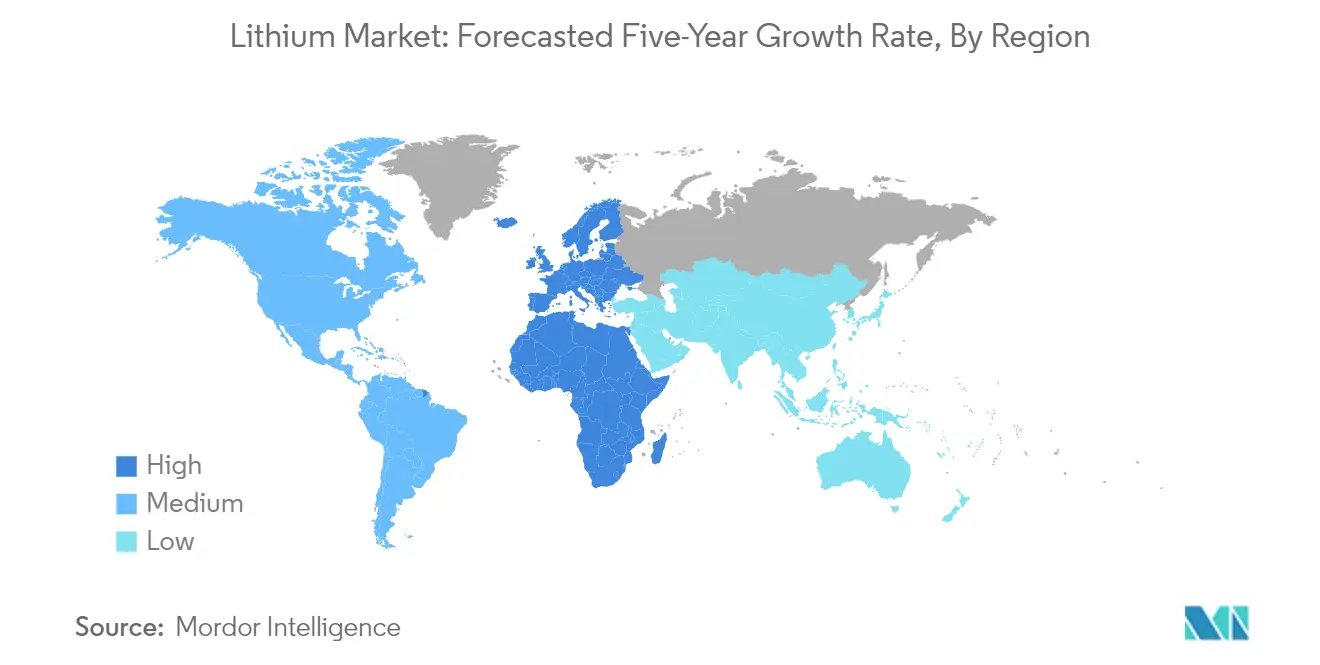
Lithium Market in China
China dominates the Asia-Pacific lithium market, commanding approximately 48% of the regional market share. The country's leadership position is reinforced by its comprehensive lithium supply chain, from processing to battery manufacturing. China's domestic lithium battery production and consumption accounts for a significant portion of various industries, with a major share assembled in new energy vehicles. The country has established itself as a global leader in electric vehicle production and battery manufacturing, supported by government initiatives and substantial investments in research and development.
Lithium Market in South Korea
South Korea emerges as the fastest-growing market in the Asia-Pacific region, with an expected growth rate of approximately 18% from 2024 to 2029. The country's rapid growth is driven by its strong presence in the global battery manufacturing sector and aggressive expansion in electric vehicle production. South Korean companies are actively investing in battery technology development and expanding their production capabilities. The country's automotive industry is rapidly transitioning to electric vehicles, with major manufacturers like Hyundai Motor Group establishing themselves as significant players in the global electric vehicle market.
Lithium Market in North America
The North American lithium market is characterized by growing investments in domestic battery production and increasing adoption of electric vehicles. The region is actively working to reduce dependency on foreign lithium supplies by developing local lithium processing capabilities and establishing robust supply chains. The market is supported by government initiatives promoting clean energy adoption and sustainable transportation solutions across the United States, Canada, and Mexico.
Lithium Market in United States
The United States leads the North American lithium market, holding approximately 82% of the regional market share. The country is experiencing substantial growth in its battery manufacturing capacity, with numerous companies announcing expansion projects and new manufacturing facilities. The U.S. government's strong support through policies and incentives has created a favorable environment for lithium-ion battery production and electric vehicle manufacturing.
Lithium Market Growth in United States
The United States also represents the fastest-growing market in North America, with a projected growth rate of approximately 22% from 2024 to 2029. This exceptional growth is driven by increasing investments in battery manufacturing facilities, rising electric vehicle adoption, and supportive government policies. The country is witnessing significant developments in battery technology and energy storage solutions, supported by substantial investments from both domestic and international companies.
Lithium Market in Europe
The European lithium market is experiencing rapid transformation driven by aggressive electric vehicle adoption targets and investments in battery manufacturing capabilities. The region's commitment to sustainable transportation and renewable energy storage has created substantial demand for lithium-based solutions. Countries across Europe are developing comprehensive strategies to secure lithium supply chains and establish domestic battery production capabilities.
Lithium Market in Germany
Germany stands as the largest lithium market in Europe, leading the region's transition toward electric mobility and energy storage solutions. The country's robust automotive industry, coupled with significant investments in battery technology and manufacturing capabilities, has established it as a key player in the European lithium industry. Germany's commitment to sustainable transportation and renewable energy integration continues to drive demand for lithium-based solutions.
Lithium Market Growth in Germany
Germany also emerges as the fastest-growing market in Europe, demonstrating exceptional growth potential in the lithium sector. The country's rapid expansion is supported by increasing electric vehicle production, growing energy storage installations, and substantial investments in battery manufacturing facilities. German automotive manufacturers are accelerating their transition to electric vehicles, driving demand for lithium-ion batteries and related technologies.
Lithium Market in South America
South America plays a crucial role in the global lithium market, with Brazil and Argentina being key players in the region. The region benefits from extensive lithium reserves and growing investments in lithium extraction and processing capabilities. Brazil emerges as both the largest and fastest-growing market in the region, driven by its expanding electric vehicle market and growing energy storage sector. The country's commitment to sustainable transportation and renewable energy integration continues to drive demand for lithium-based solutions.
Lithium Market in Middle East & Africa
The Middle East and Africa region represents an emerging market for lithium, with growing opportunities in electric vehicle adoption and energy storage applications. Saudi Arabia leads the regional market, supported by its ambitious vision for sustainable transportation and renewable energy integration. South Africa emerges as the fastest-growing market, driven by increasing investments in electric vehicle infrastructure and energy storage solutions. The region's focus on diversifying energy sources and reducing carbon emissions continues to create new opportunities for lithium applications.
Lithium Industry Overview
Top Companies in Lithium Market
The global lithium market is led by established players like SQM SA, Ganfeng Lithium, Albemarle Corporation, Allkem Limited, and Pilbara Minerals, who are driving innovation through advanced lithium extraction and processing technologies. Companies are increasingly focusing on vertical integration strategies, from mining operations to end-product manufacturing, to strengthen their market position and ensure supply chain stability. Strategic partnerships and collaborations with automotive and battery manufacturers have become crucial for securing long-term supply agreements and market expansion. The industry is witnessing significant investments in research and development for more efficient lithium extraction methods and sustainable production practices. Major players are also expanding their geographical presence through new mining projects and processing facilities across key regions like Australia, South America, and Asia to meet the growing demand from the electric vehicle and energy storage sectors.
Consolidated Market with Strong Regional Players
The lithium market exhibits a highly consolidated structure where the top five players control a significant portion of global lithium production capacity and lithium market share. The industry landscape is characterized by a mix of large-scale integrated chemical companies and specialized lithium producers, with the most dominant players having established strong positions in key lithium-producing regions. The market has witnessed several strategic mergers and acquisitions, notably the merger between Allkem and Livent, as companies seek to strengthen their market position and expand their production capabilities. The competitive dynamics are further shaped by long-term supply agreements with major end-users, particularly in the automotive and electronics sectors, creating high barriers to entry for new market participants.
The market is experiencing a transformation with increasing investments from both established players and new entrants, particularly in regions with abundant lithium resources. Companies are adopting different strategies ranging from direct lithium extraction technologies to brine and hard rock mining operations, creating diverse competitive advantages. The industry is also seeing growing involvement from government entities and regional players, especially in China and South America, who are working to secure their positions in the global supply chain through strategic partnerships and domestic production capacity expansion.
Innovation and Sustainability Drive Future Growth
Success in the lithium market increasingly depends on companies' ability to develop and implement sustainable extraction technologies while maintaining cost competitiveness. Market leaders are investing heavily in research and development to improve production efficiency and reduce environmental impact, while also securing strategic partnerships across the value chain. The ability to navigate regulatory requirements, particularly environmental regulations and resource nationalism in key producing countries, has become a critical factor for maintaining market position. Companies are also focusing on developing closed-loop recycling systems and alternative lithium sources to address supply chain sustainability and meet growing environmental concerns.
For new entrants and smaller players, success lies in identifying and developing niche market segments or specialized applications while building strategic alliances with established players. The increasing focus on supply chain regionalization and domestic production capabilities presents opportunities for local players to strengthen their market position. Companies that can demonstrate strong environmental, social, and governance (ESG) credentials while maintaining operational efficiency are likely to gain competitive advantages. The ability to secure long-term supply agreements with major end-users, particularly in the electric vehicle sector, remains crucial for sustainable growth and market expansion.
Lithium Market Leaders
-
Albemarle Corporation
-
SQM S.A.
-
Tianqi Lithium
-
Livent
-
Allkem Limited
- *Disclaimer: Major Players sorted in no particular order
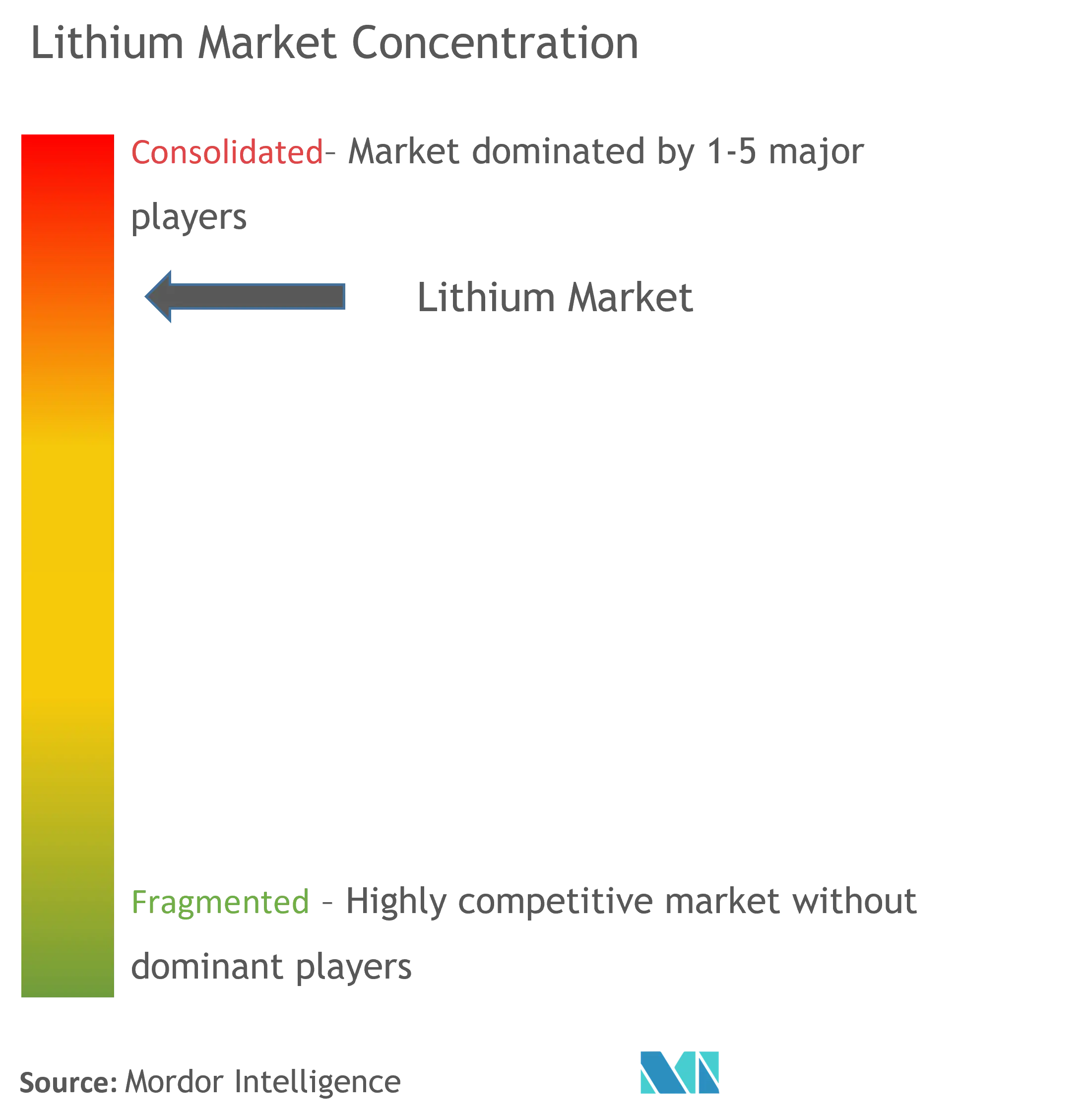
Lithium Market News
- May 2022: Mineral Resources marked a significant milestone in its lithium growth strategy with the first new spodumene concentrate delivered at the Wodgina Lithium Project in the Pilbara region of Western Australia.
- April 2022: SQM SA planned to invest USD 900 million in 2022 as part of its plan to increase lithium carbonate and hydroxide production capacity. The company has plans to enhance lithium carbonate production capacity to 180,000 metric ton per annum in the future. Furthermore, the capacity is likely to reach 210,000 tons by early 2023.
- April 2022: Avalon Advanced Materials Inc. signed an agreement with RenJoules International Ltd, an Essar Company, to become a strategic partner and co-developer in support of Avalon's plans to establish a regional lithium battery materials supply chain. This agreement may fulfill the needs of upcoming electric vehicle and battery manufacturers in Ontario and other regions.
Lithium Market Report - Table of Contents
1. INTRODUCTION
- 1.1 Study Assumptions
- 1.2 Scope of the Study
2. RESEARCH METHODOLOGY
3. EXECUTIVE SUMMARY
4. MARKET DYNAMICS
-
4.1 Drivers
- 4.1.1 Accelerating Demand for Electric Vehicles
- 4.1.2 Increasing Usage and Demand by Portable Consumer Electronics
- 4.1.3 Other Drivers
-
4.2 Restraints
- 4.2.1 Demand-supply Gap in the Lithium Market
- 4.2.2 Other Restraints
- 4.3 Industry Value Chain Analysis
-
4.4 Porter's Five Forces Analysis
- 4.4.1 Bargaining Power of Suppliers
- 4.4.2 Bargaining Power of Buyers
- 4.4.3 Threat of New Entrants
- 4.4.4 Threat of Substitute Products and Services
- 4.4.5 Degree of Competition
- 4.5 Pricing Analysis
- 4.6 Technological Snapshot
5. MARKET SEGMENTATION
-
5.1 Type
- 5.1.1 Metal
- 5.1.2 Compound
- 5.1.2.1 Carbonate
- 5.1.2.2 Chloride
- 5.1.2.3 Hydroxide
- 5.1.3 Alloy
-
5.2 Application
- 5.2.1 Battery
- 5.2.2 Grease
- 5.2.3 Air Treatment
- 5.2.4 Pharmaceuticals
- 5.2.5 Glass/Ceramic (Including Frits)
- 5.2.6 Polymer
- 5.2.7 Other Applications
-
5.3 End-user Industry
- 5.3.1 Industrial
- 5.3.2 Consumer Electronics
- 5.3.3 Energy Storage
- 5.3.4 Medical
- 5.3.5 Automotive
- 5.3.6 Other End-user Industries
-
5.4 Geography
- 5.4.1 Production and Reserve Analysis
- 5.4.1.1 Australia
- 5.4.1.2 Chile
- 5.4.1.3 China
- 5.4.1.4 Argentina
- 5.4.1.5 Zimbabwe
- 5.4.1.6 United States
- 5.4.1.7 Other Regions
- 5.4.2 Consumption Analysis
- 5.4.2.1 Asia-Pacific
- 5.4.2.1.1 China
- 5.4.2.1.2 India
- 5.4.2.1.3 Japan
- 5.4.2.1.4 South Korea
- 5.4.2.1.5 Australia & New Zealand
- 5.4.2.1.6 Rest of Asia-Pacific
- 5.4.2.2 North America
- 5.4.2.2.1 United States
- 5.4.2.2.2 Canada
- 5.4.2.2.3 Mexico
- 5.4.2.3 Europe
- 5.4.2.3.1 Germany
- 5.4.2.3.2 United Kingdom
- 5.4.2.3.3 France
- 5.4.2.3.4 Italy
- 5.4.2.3.5 Nordic Countries
- 5.4.2.3.6 Rest of Europe
- 5.4.2.4 South America
- 5.4.2.4.1 Brazil
- 5.4.2.4.2 Argentina
- 5.4.2.4.3 Rest of South America
- 5.4.2.5 Middle East and Africa
- 5.4.2.5.1 Saudi Arabia
- 5.4.2.5.2 South Africa
- 5.4.2.5.3 Rest of Middle East and Africa
6. COMPETITIVE LANDSCAPE
- 6.1 Mergers and Acquisitions, Joint Ventures, Collaborations, and Agreements
- 6.2 Market Share (%) Analysis
- 6.3 Strategies Adopted by Leading Players
-
6.4 Company Profiles (Overview, Financials, Products and Services, and Recent Developments)
- 6.4.1 Albemarle Corporation
- 6.4.2 Allkem Limited
- 6.4.3 Ganfeng Lithium Co. Ltd
- 6.4.4 Lithium Australia NL
- 6.4.5 Livent
- 6.4.6 Mineral Resources
- 6.4.7 Morella Corporation Limited
- 6.4.8 Sichuan Yahua Industrial Group Co. Ltd
- 6.4.9 SQM SA
- 6.4.10 Tianqi Lithium
- 6.4.11 Avalon Advanced Materials Inc.
- 6.4.12 Pilbara Minerals
7. MARKET OPPORTUNITIES AND FUTURE TRENDS
- 7.1 Growing Adoption in Smart Grid Electricity
- 7.2 Other Opportunities
Lithium Industry Segmentation
Lithium is a soft, silvery-white alkali metal with atomic number three and the symbol Li. The main sources of lithium are underground lithium-containing brine reservoirs and lithium-containing rocks, such as spodumene. The lithium market is segmented by type, application, end-user industry, and geography. By type, the market is segmented into metal, compound, and alloy. By application, the market is segmented into battery, grease, air treatment, pharmaceuticals, glass/ceramic (including frits), polymer, and other applications. By end-user industry, the market is segmented into industrial, consumer electronics, energy storage, medical, automotive, and other end-user industries. The report also covers the market size and forecasts for the lithium market in 16 countries across major regions. For each segment, the market sizing and forecasts have been carried out on the basis of volume (lithium carbonate equivalent (LCE) kilotons).
| Type | Metal | |||
| Compound | Carbonate | |||
| Chloride | ||||
| Hydroxide | ||||
| Alloy | ||||
| Application | Battery | |||
| Grease | ||||
| Air Treatment | ||||
| Pharmaceuticals | ||||
| Glass/Ceramic (Including Frits) | ||||
| Polymer | ||||
| Other Applications | ||||
| End-user Industry | Industrial | |||
| Consumer Electronics | ||||
| Energy Storage | ||||
| Medical | ||||
| Automotive | ||||
| Other End-user Industries | ||||
| Geography | Production and Reserve Analysis | Australia | ||
| Chile | ||||
| China | ||||
| Argentina | ||||
| Zimbabwe | ||||
| United States | ||||
| Other Regions | ||||
| Consumption Analysis | Asia-Pacific | China | ||
| India | ||||
| Japan | ||||
| South Korea | ||||
| Australia & New Zealand | ||||
| Rest of Asia-Pacific | ||||
| North America | United States | |||
| Canada | ||||
| Mexico | ||||
| Europe | Germany | |||
| United Kingdom | ||||
| France | ||||
| Italy | ||||
| Nordic Countries | ||||
| Rest of Europe | ||||
| South America | Brazil | |||
| Argentina | ||||
| Rest of South America | ||||
| Middle East and Africa | Saudi Arabia | |||
| South Africa | ||||
| Rest of Middle East and Africa | ||||
Lithium Market Research FAQs
How big is the Lithium Market?
The Lithium Market size is expected to reach 0.85 million LCE tons in 2025 and grow at a CAGR of 19.57% to reach 2.07 million LCE tons by 2030.
What is the current Lithium Market size?
In 2025, the Lithium Market size is expected to reach 0.85 million LCE tons.
Who are the key players in Lithium Market?
Albemarle Corporation, SQM S.A., Tianqi Lithium, Livent and Allkem Limited are the major companies operating in the Lithium Market.
Which is the fastest growing region in Lithium Market?
Europe is estimated to grow at the highest CAGR over the forecast period (2025-2030).
Which region has the biggest share in Lithium Market?
In 2025, the Asia-Pacific accounts for the largest market share in Lithium Market.
What years does this Lithium Market cover, and what was the market size in 2024?
In 2024, the Lithium Market size was estimated at 0.68 million LCE tons. The report covers the Lithium Market historical market size for years: 2019, 2020, 2021, 2022, 2023 and 2024. The report also forecasts the Lithium Market size for years: 2025, 2026, 2027, 2028, 2029 and 2030.
Our Best Selling Reports
Lithium Market Research
Mordor Intelligence offers comprehensive insights into the lithium market through detailed industry analysis and consulting expertise. Our research thoroughly covers the entire value chain. This includes lithium mining, lithium extraction, and lithium processing, along with the production of lithium compounds such as lithium carbonate and lithium hydroxide. The report examines key segments like battery metals and energy storage materials. It also provides an in-depth analysis of lithium chemicals and industrial lithium applications. Our expert analysts track the latest developments in lithium ore processing, lithium brine extraction, and lithium spodumene refinement technologies.
Stakeholders benefit from our detailed lithium market forecast and lithium industry outlook. These include crucial insights into lithium price trends and market growth projections. The report, available as an easy-to-download PDF, offers comprehensive coverage of the lithium mining industry and battery metals market. It places particular focus on EV battery materials and lithium battery materials. Our analysis encompasses the entire spectrum of lithium minerals and lithium salts, providing valuable insights for industry participants across the lithium compounds market and lithium carbonate market. The report delivers actionable intelligence on market value trends and regional market dynamics, supporting strategic decision-making across the industry.

